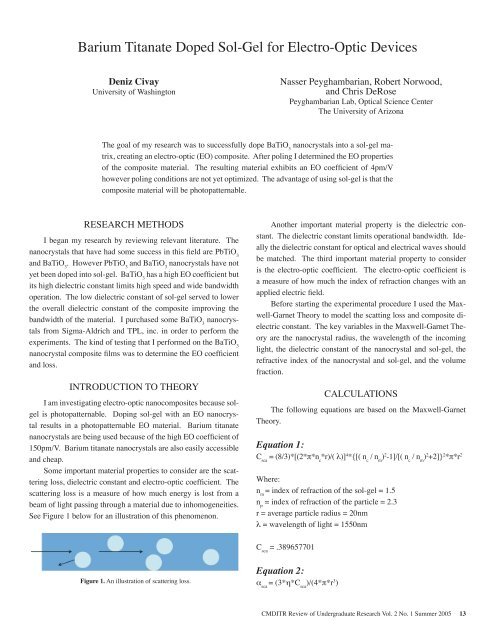Student Project Abstracts 2005 - Pluto - University of Washington
Student Project Abstracts 2005 - Pluto - University of Washington
Student Project Abstracts 2005 - Pluto - University of Washington
Create successful ePaper yourself
Turn your PDF publications into a flip-book with our unique Google optimized e-Paper software.
Barium Titanate Doped Sol-Gel for Electro-Optic DevicesDeniz Civay<strong>University</strong> <strong>of</strong> <strong>Washington</strong>Nasser Peyghambarian, Robert Norwood,and Chris DeRosePeyghambarian Lab, Optical Science CenterThe <strong>University</strong> <strong>of</strong> ArizonaThe goal <strong>of</strong> my research was to successfully dope BaTiO 3nanocrystals into a sol-gel matrix,creating an electro-optic (EO) composite. After poling I determined the EO properties<strong>of</strong> the composite material. The resulting material exhibits an EO coefficient <strong>of</strong> 4pm/Vhowever poling conditions are not yet optimized. The advantage <strong>of</strong> using sol-gel is that thecomposite material will be photopatternable.RESEARCH METHODSI began my research by reviewing relevant literature. Thenanocrystals that have had some success in this field are PbTiO 3and BaTiO 3. However PbTiO 3and BaTiO 3nanocrystals have notyet been doped into sol-gel. BaTiO 3has a high EO coefficient butits high dielectric constant limits high speed and wide bandwidthoperation. The low dielectric constant <strong>of</strong> sol-gel served to lowerthe overall dielectric constant <strong>of</strong> the composite improving thebandwidth <strong>of</strong> the material. I purchased some BaTiO 3nanocrystalsfrom Sigma-Aldrich and TPL, inc. in order to perform theexperiments. The kind <strong>of</strong> testing that I performed on the BaTiO 3nanocrystal composite films was to determine the EO coefficientand loss.INTRODUCTION TO THEORYI am investigating electro-optic nanocomposites because solgelis photopatternable. Doping sol-gel with an EO nanocrystalresults in a photopatternable EO material. Barium titanatenanocrystals are being used because <strong>of</strong> the high EO coefficient <strong>of</strong>150pm/V. Barium titanate nanocrystals are also easily accessibleand cheap.Some important material properties to consider are the scatteringloss, dielectric constant and electro-optic coefficient. Thescattering loss is a measure <strong>of</strong> how much energy is lost from abeam <strong>of</strong> light passing through a material due to inhomogeneities.See Figure 1 below for an illustration <strong>of</strong> this phenomenon.Another important material property is the dielectric constant.The dielectric constant limits operational bandwidth. Ideallythe dielectric constant for optical and electrical waves shouldbe matched. The third important material property to consideris the electro-optic coefficient. The electro-optic coefficient isa measure <strong>of</strong> how much the index <strong>of</strong> refraction changes with anapplied electric field.Before starting the experimental procedure I used the Maxwell-GarnetTheory to model the scatting loss and composite dielectricconstant. The key variables in the Maxwell-Garnet Theoryare the nanocrystal radius, the wavelength <strong>of</strong> the incominglight, the dielectric constant <strong>of</strong> the nanocrystal and sol-gel, therefractive index <strong>of</strong> the nanocrystal and sol-gel, and the volumefraction.CALCULATIONSThe following equations are based on the Maxwell-GarnetTheory.Equation 1:C sca= (8/3)*[(2*π*n c*r)/( λ)] 4 *{[( n c/ n m) 2 -1]/[( n c/ n m) 2 +2]} 2 *π*r 2Where:n m= index <strong>of</strong> refraction <strong>of</strong> the sol-gel = 1.5n p= index <strong>of</strong> refraction <strong>of</strong> the particle = 2.3r = average particle radius = 20nmλ = wavelength <strong>of</strong> light = 1550nmC sca= .389657701Figure 1. An illustration <strong>of</strong> scattering loss.Equation 2:α sca= (3*η*C sca)/(4*π*r 3 )CMDITR Review <strong>of</strong> Undergraduate Research Vol. 2 No. 1 Summer <strong>2005</strong> 13




